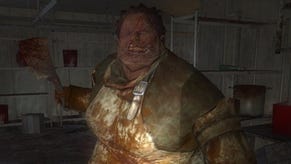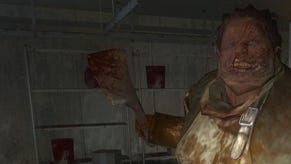Condemned
The devil's in the details. Better find him before he finds you.
Next-generation consoles (by which I, in this context, and all the publishers in the world in every context mean Xbox 2 and PlayStation 3. You know, the phrase "Next-generation consoles" is, to my mind, a neatly ambiguous term that allows publishers to either support Revolution or plausibly deny they ever intended to when it actually turns out to be a rotating banana wrapped in pasta housing a microchip that mimics Shigeru Miyamoto's higher brain functions during an acid trip and projects them onto a giant statue of Charmander reading philosophy) are boring. So, enormous, self-indulgent sentence scything caveats aside: Next-generation consoles are boring. "Ooh, la di dah, this one's got those eight mega rivets per cubic glockenspiel synaptic Hoover bananas." Fantastic. We can all basically assume that the games will a) look nicer, b) sound nicer, and c) be able to do more complicated things and much greater volumes of them. Right? Okay, granted, not everyone's as nonplussed about console hardware transitions as I am, but whether you agree or not it's certainly good news for you, my dear reader, because it means that when I do finally get to talk about next-generation console games, I'm bursting to start looking forward after months of peering at Darth Vader's toaster and pretending to care about whether the next will actually make my toast for me.
Condemned is a bloody brilliant place to start, too, because it takes advantage of its newfound power in an interesting way. Targeted at "next-generation consoles" (told ya) and PC, it's basically going to be out on Xbox 2 later this year from what I can fathom, and it aims to take full advantage of the fact that it can afford to look and feel enormously detailed every step of the way. So much so that it's rejected accepted first-person action wisdom and slowed every step down so you can soak up the ambience.
It's about chasing down serial killers in hellholes. From what's been said, it sounds like it adopts the mechanical principles of a first-person shooter but the mentality of a crime thriller, building detective work into cute little gamey mechanics - like intuition as an on-screen prompt indicating you should explore the area using your forensic tools - and using the excessive grunt of next-generation hardware to create a world that it's much more interesting to pour over at the sometimes laborious pace of a painstaking and distant pursuit. It's influenced by the likes of Silence of the Lambs, and the buzzword is 'plausibility' - so much so that Monolith actually sent location scouts out to find the most disgusting hovels in all of Seattle, the worst elements of which were then recreated to crop up throughout the game's environments. From stained mattresses lying in puddles of god knows what to ugly green bloodstained doors with the paint chipped off halfway up. Everyone loves high concept, so let's go for Silent Hill meets CSI.
You play a chap called Ethan Thomas, an FBI agent (of course) from the Serial Crimes Unit, and you ply your trade by following various clues scattered around your excessively detailed, believably interactive environments using an array of forensic tools (including a laser light for footprints, UV light for bodily fluids, gas spectrometer for gases, and a 3D scanner for sending it back to the lab) to piece together your quarry's path, complete with flashback-style "mind's eye" glimpses of how the killer must have eluded you when Thomas finds enough clues to establish that, hey, those marks on the floor suggest he pushed that object in front of that door - why? When push comes to shove, you're limited to the weapons and ammunition you brought with you, but you can always rip a pipe from the wall or grab a nearby plank of wood and put it to good use. And everything you do or see will be rendered to an unprecedented degree of detail using layer upon layer of special effects and clever graphical tomfoolery to create a believable playground. Sorry, hunting ground.
The pace is slow but that's the point. Monolith's creating an array of gloomy and imposing rundown environments that are there to be carefully probed, but not without fostering a severe sense of trepidation. Imagine a game full of underground dungeons like Buffalo Bill's, each brought to life with richly detailed textures that use normal mapping (the technique that creates the illusion of 3D surfaces in Doom III, Riddick and Half-Life 2) along with other forms of mapping (colour, specular), shrouded in a gloom marshalled by volumetric lighting and other atmospheric effects, so that even your flashlight beam fades in the distance, giving you a glimpse of unnerving (dynamically shadowy) motion just out of focus. They want to make you tense up. They want to make you feel like things are happening even when you're completely alone and they want you to feel uneasy about them. They want it to feel like a real world pursuit, and, of course, since all your accepted wisdom on serial killers is based on fiction and second-hand accounts (unless you're extremely unlucky), subconsciously you'll fully expect them to be able to appear out of nowhere, be superhuman and capable of incalculably horrific things. Influenced by but also indebted to the likes of Silence of the Lambs, then, for ingraining us all with such lofty expectations for nutcases. Bit of a bonus. If Condemned really can tap into that, then it'll validate all those hazy boasts about the sorts of things next-gen will bring us.
To live up to the nervous build-up it's fashioning, Monolith says flashpoints will be guttural clashes, complete with the panic of trying to find something to use to fight back. It won't just be one for each of the game's eight stages though. You're in pursuit of just the one target, but each area will also be teeming with that location's "condemned", unfortunate characters who range from indignant squatters to horrendously disfigured shut-ins who strongly object to your choice of pathway. And of course if you're fumbling around in the dark trying to identify an unknown patch of blood, chatting to your lab-rat partner analysing the results in Langley, you're going to find they sneak up on you. Not quite as scary as the killer himself, but then it could be him, couldn't it? Better keep your wits about you.
With that much computing power at its disposal, Monolith's making sure that even the hired help gives you something to worry about. In a game where tension is meant to underpin everything, these chaps have to be clever. Or, rather, unpredictable. Which is why they'll try to sneak up at you and chuck things at you before you've seen them, try to push you down stairs, and find nearby objects to attack you with. If you whip out a gun, they'll retreat and look for a better weapon. Some will even try to lure you into traps - like a row of shelves stacked with heavy boxes ready to fall on you and spill their weighty contents in a manner consistent with the chaotic rhythm of Havok 3.0 physics. Some will be more violent and unhinged than others, but all pose a risk and all have better ideas about dealing with you than simply repeating a particular quickly-observed attack pattern. And despite the processing burden their instinctive behaviour creates, Xbox 2 will be able to deliver a lot of them - in separate groups. You may find yourself fleeing a building pursued by two separate mobs with another lurking outside; all kept simmering and occasionally sent frothing by the hardware without a hint of separation or diminished involvement from any. Who knows? Perhaps this sort of all-round depth and detail will be pretty standard fare in the next-generation console war, but we could probably stomach this sort of "blasé" - especially if it gave developers licence to roam free of accepted convention.
Condemned is certainly trying. To paraphrase something Epic Games vice-pres Mark Rein said the other day - it is about the graphics, and it's also about the grunt. And there's no need to be snobby; it's a good thing that it's about the graphics and the grunt. The jump in detail in every sense this time around is allowing Monolith to steer Condemned into the realm of truly atmospheric, slow-paced thrillers, full of subway stations, rundown factories, abandoned shops, even burned out libraries - brooding places full of inexplicable noises, the sight and sound of rubbish spilling, fluttering and tumbling from a toppled bin as you wheel round to find no one there; caging horrors that use seven different maps built from eight million polygons to appear truly graphically abhorrent when they eventually venture forth from the shadows to creep up behind you, their gentle footsteps audibly passing through gravel, concrete, glass, a puddle of blood...
When you do fight, it'll be frantic and realistic. Blood sprays from wounds, body parts can be horribly contorted as you smash them with metal bars and other of the 20 melee weapons in the game, plastic armour cracks away revealing tortured faces, and even to you a few blows from a 2x4 will be fatal. You can always club someone with your gun if you can't find something handy, but if you overdo it it'll break, and then you won't have much use for the bullets you were trying to save for, you know, him. You have a taser, but what good's a taser when you don't know they're coming?
It's going to be a horrific pursuit. And if it intends to keep us as riveted as the hyperbolic heraldry it's received from the US press suggests it does, it's going to need a story that ties it all together. Frankly, we've little doubt that Monolith can make a beautiful, or, rather, horrifically disgusting world that can torture and terrify us as we pick it apart using neatly woven and satisfying mechanics, gritting our teeth through vicious, unconventional life or death scuffles with people who don't care about the life part, but, to return once again to Silence of the Lambs, it took a certain manner of storytelling to make that chase so engrossingly uncomfortable. Monolith knows this, for certain, professing that the sensation of unravelling a mystery is key, and pointing out that what drives a serial killer is more interesting than catching him or killing him; the team says the story will show you how these people become who they are, with a shadowy element said to be responsible for the killers' and the condemned's descent into madness, exploring themes of madness, self-destruction and identity amongst other things - largely played out in-game. I sincerely hope they get it right, because the cruellest twist would be something this interesting falling short. It'd be enough to drive me to murder, and wouldn't that be ironic...




